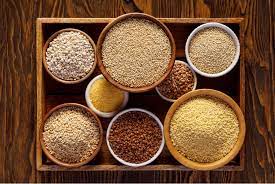NUTRITIONAL IMPORTANCE OF MILLETS
Millions of people around the world depend on sorghum and millets such as Pearl millet, Finger millet, Kodo millet, Proso millet, Foxtail millet, Little millet, and Barnyard millet.
These are usually rain-fed crops grown in low-rainfall zones, and thus reclaim greater value for long-term agriculture and food security.
Almost all millets are used by humans in most developing countries, but their use in developed countries has largely been limited to animal feed. Millets have a similar nutritional profile to major cereals and are a healthy source of fibre.
Nutrition, micronutrients, and phytochemicals are also important components of a healthy diet. Soaking, malting, decortication, and frying are also examples of processing.
techniques.
Antioxidant quality and behaviour was influenced (Saleh et al., 2013). Finger millet contains 12-16 percent protein and 2-5 percent lipids, while sorghum and most millets contain around 10% protein and 3.5 percent lipids.
Micronutrients such as vitamins and minerals are abundant in sorghum and millets. Prolamin (kaffirin) makes up the majority of sorghum protein.
The millets, on the other hand, have a stronger amino acid profile and have a special function of reducing digestibility when cooked.
It has been successful. It has been documented that sorghum proteins are slightly less digestible when cooked than other cereal proteins. For certain food types, there could be a health advantage. Millets, on the other hand, have less cross-linked prolamins, which may be another factor leading to millet.
PROTEIN DIGESTABILITY
Niacin, found in millet, aids in the management of over 400 enzyme reactions in the body. Niacin is therefore essential for maintaining good skin and organ function.
In reality, it’s suchan essential compound that it’s often used to enrich processed foods. Millet is a good source of beta-carotene, particularly the darker varieties.
This natural pigment acts as an antioxidant and a precursor to vitamin A, assisting the body in the battle against free radicals and promoting eye protection.
Millets are not only nutritionally similar to major cereals, but they are also excellent sources of carbohydrates, micronutrients, and phytochemicals of nutraceutical properties. Millets have a protein content of 7-12 percent, a fat content of 2-5 percent, a carbohydrate content of 65-75 percent, and a dietary fibre content of 15-20 percent.
Pearl millet is one of them, and it has a significant amount of it.
Protein (12-16%) and lipids (4-6%) are higher in finger millet, while protein (6-8%) and fat are lower in finger millet (1.5-2 %).
The Millet protein has a higher basic amino acid balance than maize protein.
Pearl millet has a higher niacin content than all other cereals, but finger millet proteins are peculiar due to their high sulphur content.
Millet proteins, like cereal proteins, are low in lysine, but they work well in combination with lysine-rich vegetable (leguminous) and animal proteins to create nutritionally healthy composites with high biological value.
When compared to fine cereals, small millets are more nutritional. The richest source of calcium (300-350 mg/100 g) is finger millet, while other small millets are high in phosphorous and iron.

